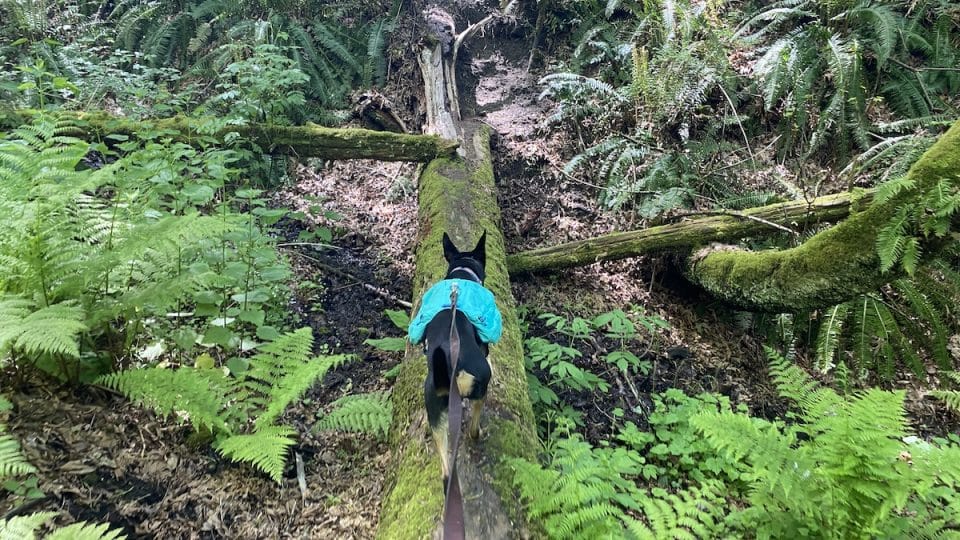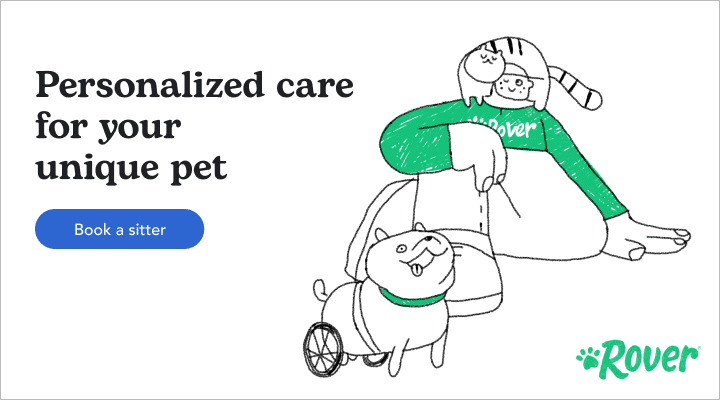- This post contains affiliate links. Read more here.
- Not a substitute for professional veterinary help.
If you and your dog love to hike, chances are good you’ve considered a dog pack, perhaps while loading your own stuffed backpack with all your pup’s gear. Having your dog carry some of their own water, treats, kibble, or poop bags can make a big difference on the trail—and not just when it comes to lightening your load. Carrying supplies gives some dogs a valuable sense of purpose and helps them burn extra energy, adding interest and challenge to an outing.
At about a year-and-a-half old, my Australian Cattle Dog mix, Pepper, is at a great age to get used to the idea of carrying a little bit of gear on our adventures. We put the Ruffwear dog pack to the test in the wilds to find out what works, what doesn’t, and who can get the most mileage out of this sporty pup pack.
The Ruffwear Front Range Dog Day Pack
There are lots of styles of dog pack out there. Some packs prioritize maximum sturdiness and durability for multi-day hikes, coming with their own water bladders (such as Ruffwear’s Singletrak) or dog bowls. Others are meant for more casual day trips, emphasizing removable saddlebags or especially lightweight designs.
For our part, we wanted something that would be comfortable, adjustable, durable, and came from a trusted brand. Ruffwear makes a whole line of dog packs with different perks, and the Front Range in particular suited our needs. It has three leash attachment points, including one in front—we use a front-clip harness or Gentle Leader with Pepper to deter pulling.
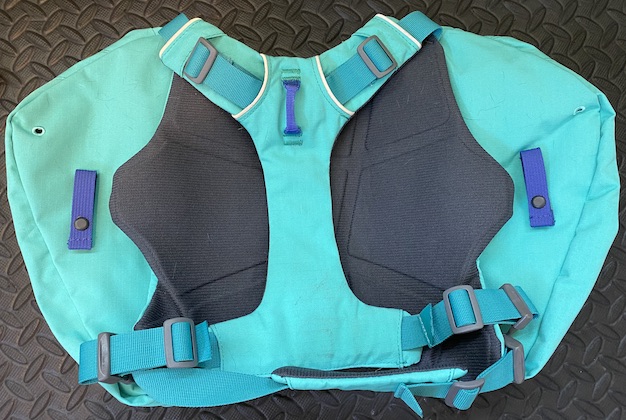
The Ruffwear Front Range Dog Pack laid out flat.
We also considered the pack’s capacity relative to Pepper’s weight. According to Ruffwear and others, the weight of a pack and its contents should stay under 25% of your dog’s weight. Pepper is 40 pounds, which means she could carry at most 10 pounds. Before we got started, we measured Pepper per Ruffwear’s size guide. That put her in a size small for the Front Range model.
Before buying any dog pack, it’s also a good idea to consult your vet, who can help you rule out options that won’t be a good fit for your particular pup’s size and shape, age, or needs.
How To Train a Dog To Wear a Pack
Getting a dog on board with wearing a pack is a lot like getting them used to other gear: start slowly and keep sessions short and positive.
- Let your pup inspect the pack, then put it on for just a minute or so at a time, offering lots of praise and treats.
- Try it inside at first—it will take your dog time to figure out how to move and clear obstacles with the new bulk on their bodies; if you’ve ever had to have your dog wear a cone due to a medical issue or recovery, you’re already familiar with this idea.
- Start with the pack empty, then gradually begin to add weight. Make sure that weight stays relatively even on both sides.
Testing Out the Ruffwear Front Range Dog Pack
Armed with the above tips, we got started with the Ruffwear. First I unwrapped it and let Pepper check it out; I scrunched it up and unzipped the pouches on the floor with her. I gave her a few treats, then left the pack hanging around with her leash and other gear. Later in the day, I put it on her. The front of this harness goes over the head, so I used the Gentle Leader trick of giving her a treat through the neck hole, encouraging Pepper to pop her head through it to get the reward.
Adjusting the Ruffwear dog pack was a little trickier than we anticipated. The multiple adjustment buckles are very well-made—and tight. So much so that I couldn’t really adjust the pack with Pepper in it. I took it off, adjusted, and put it back on several times while treating Pepper for her patience. The good news? Once you get these buckles dialed in, they’re not going anywhere.
Once the pack was on and fitted, we walked around the house and out into the backyard. Pepper was a bit delicate about walking at first, trying to figure out the new borders of her body via a couple of run-ins with the doorway.
Because the sun was shining during an extremely unpredictable and rainy spring, we decided there was no time like the present to hook on the leash and take a spin around the neighborhood. We also thought it would help create a positive association with walking and exploring. But Pepper’s pretty adventurous and has a high tolerance for our antics (mostly because there are always treats involved). For pups who are slower to adjust, try a few laps around the backyard first.
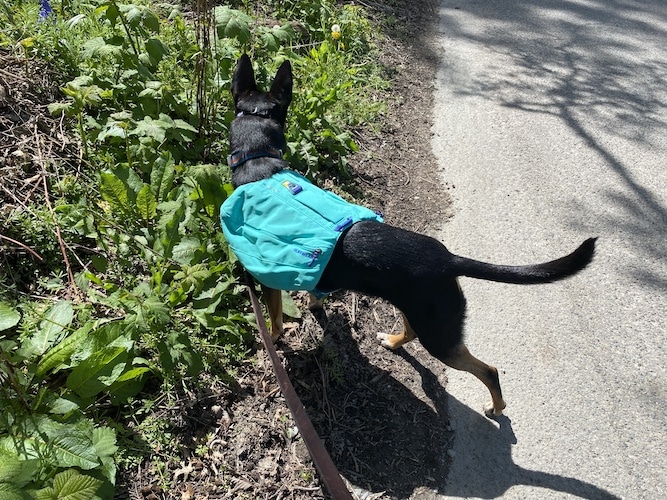
Heading out on Pepper’s first dog pack adventure.
Pepper quickly got used to wearing the Ruffwear dog pack. We took her to our local old-growth forest park, and she had a ball, forgetting about the pack pretty quickly.
While we did choose this Ruffwear model for the front ring, in practice, it wasn’t a great location for the leash, which got in the way of her front leg and hindered her walking. I switched to the back ring, but if pulling became an issue, I would likely just use her Gentle Leader in addition to the pack.
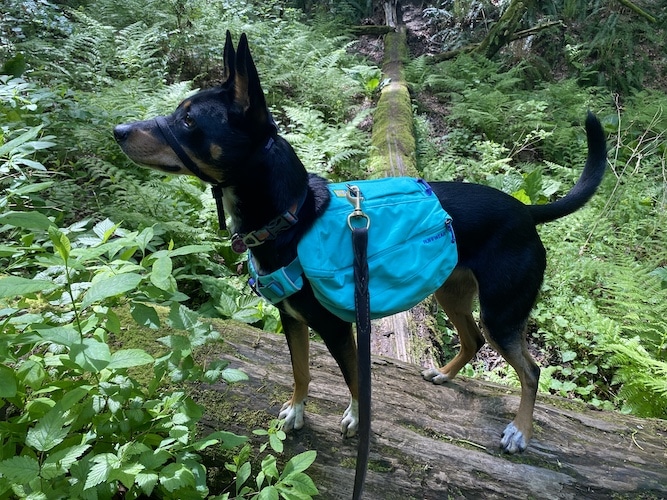
We used the back loop for the leash but left Pepper’s Gentle Leader on in case of pulling.
As we went on additional excursions, I started adding a bit of weight with Ziploc bags of kibble. The stretchy pockets in the pack make it so you can reduce jostling. We haven’t yet worked up to a full pack, but Pepper sees the pack now and looks forward to a walk, just like when we pull out her other gear. So getting her used to it: Check.
What We Thought of the Ruffwear Front Range Dog Pack
The Ruffwear Front Range is a well-made dog pack that is likely to see your dog through many hikes. We love the sturdy 300-Denier polyester ripstop fabric, the comfy foam padding, and extra pockets inside each of the saddle bags.
While we like the idea of the three well-constructed leash attachments, in practice, the location of the front ring didn’t seem to work well for Pepper’s particular build. In addition, the fabric that makes this model so sturdy also makes it a little bit bulkier than some other packs. So if your priority is a sleek pack, you might look at some of Ruffwear’s other models, like the Singletrak, in addition to other brands.
What works great:
- Weight-forward design and solid strapping make for a very stable pack
- Dense padding keeps things comfy
- Stretchy internal pockets
- Reflective accents plus a loop you can hook a light on
- Low-profile top handle for giving your dog a boost when needed
- Great color options
What to consider:
- Unlike some packs, this doesn’t come with its own water bladder/bottle
- Bulkier than some other packs
- Not all dogs will love the over-the-head fit
Keep in mind that your dog is likely to be warmer when wearing a pack, both because of the fabric itself and because of the extra work your pup puts in carrying it. Remember to keep an eye on your dog and offer them extra water, particularly when the weather is warmer. Happy hiking!
